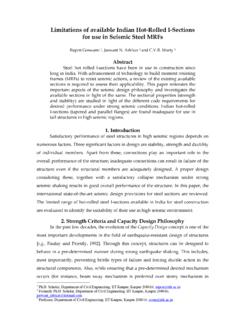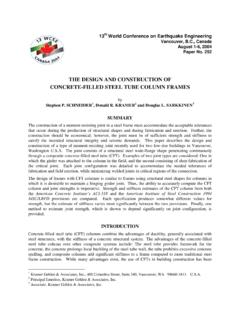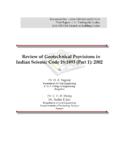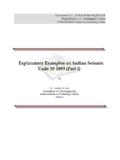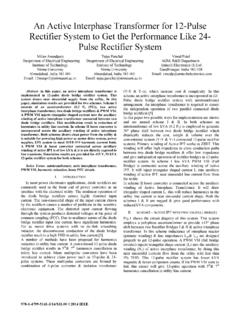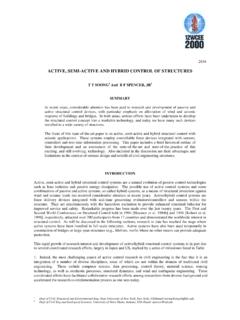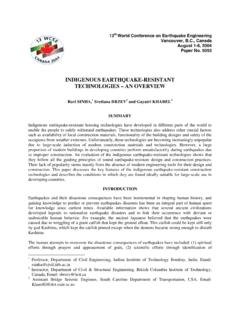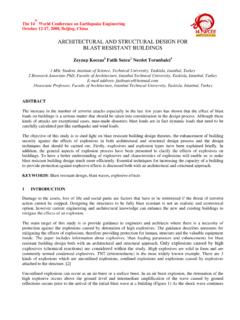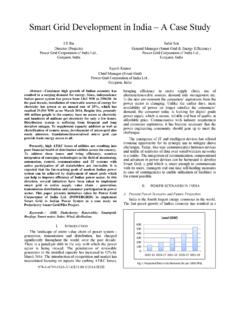Transcription of Efficiency of bracing systems for seismic …
1 Efficiency of bracing systems for seismic rehabilitation of steel structures M. N. Chimeh & P. Homami Kharazmi (Tarbiat Moallem) University, Tehran, Iran SUMMARY: In most conventional cases, steel frame structures which have insufficient strength or stiffness against lateral forces can be rehabilitated by bracing systems . Braces could be added without substantially increasing the mass of the structures while the structures could be considerably strengthened and stiffened. Generally, one of the most important issues is to find the most efficient system amongst the various bracing systems . The present study has compared the seismic performance of two steel structures rehabilitated by six different bracing systems . The structures were designed considering performance base method and were analyzed using both non-linear static and dynamic analysis. The behavior of rehabilitated structures by X braced frames; Chevron braced frames (Inverted-V- braced frames and V braced frames), Zipper columns and EBF with long and short link beams have been compared and the results showed that the Zipper columns bracing system and short linked EBF.
2 Are the most ductile systems while the EBF system showed the most Efficiency . Keywords: steel bracing systems ; seismic rehabilitation ; CBF; EBF; Zipper columns bracing 1. INTRODUCTION. Iran is one of the seismic zones of the world and many buildings in the country have been designed against earthquake on the basis of the old rules and codes. So, seismic rehabilitation of the existing structures should be considered. The design of earthquake resistant buildings has progressed in recent years. Existing structures have designed according to the old strength based procedure and most of them need to become rehabilitated. Due to the fact that most steel structures which designed and constructed in the past are weak against earthquake, this research studies different ways for seismic rehabilitation of a steel building. It is necessary to study the traditional methods beside the new methods for seismic rehabilitation to select the best and the most efficient method.
3 2. bracing system . Buildings Surveyed in this research are residential structures with steel skeletons with 8 and 4 stories. The studied structures are residential and located in Tehran. Tehran is one of the regions with relatively high seismic risk. It is assumed that in the direction of x the structures have weak bracing system and in the direction of y they have medium ductile moment frames, which have no need for rehabilitation . The plans of the structures are regular and the length of each span is 6 m ( ). Figure 3D view and typical plan of the studied buildings Concentrically braced frames Concentrically braced frames have suitable lateral stiffness to prevent relative drift due to lateral load impacts resulting from earthquake. Such braces are part of relatively stiff systems and compatible with common needs of architecture with varied forms (Fig. ). Concentrically braced frames are used in different forms such as cross, diametric and Chevron (Az-hari , Mirghaderi R.)
4 , 2011). Figure Different types of concentrically braced frames Generally, the use of bracings instead of Shear walls provides lower stiffness and resistance for a structure but it should not be forgotten that such a system has lower weight and more useful for architectural purposes. Use of braces for seismic rehabilitation of structures should not cause any torsion disorder and designers should be aware of increasing the axial loads of columns in bracing panels. The probable uplift in columns and foundations should be controlled too (Az-hari , Mirghaderi R., 2011). Figure Tensile and compressive bracing unbalanced force Among Concentrically braced frames, Chevron bracing frames are better and more suitable for architectures due to passage and embedment of door and window but weakness of the Chevron bracings is unbalanced force in beam due to buckling of braces (Fig. ). There are two methods for solving this problem. First method is to use Zipper column and the second method is to use of V and Inverted-v- braces alternatively in stories (Fig.
5 (Taghinezhad R., 2009). ZIPPER COLUMN. Figure Chevron bracings K shaped bracings should not be used in the rehabilitation of steel frames. Because a destructive unbalanced force may appear in columns (Fig. ) (Taghinezhad R., 2009). Figure Unbalanced force in K shaped bracing column Eccentrically braced frames (EBF). Although eccentrically braced frames (EBF) have a lower stiffness than the concentrically braced frames (CBF), they show more ductile behavior. In fact, eccentrically braced frames are a suitable combination of moment resisting frames and eccentrically braced frames. In early 1970, eccentrically braced frames were used for the first time in Japan due to both properties of moment frames (high ductility) and concentrically braced frames (high stiffness). Eccentrically braced frames can be used in different forms depending on the location of the link beam (Fig. ) (Helmuth K ber, Bogdan _tefPnescu , 2003, & Az-hari , Mirghaderi R.)
6 , 2011). Figure Types of eccentrically braced frames depending on the location of the link beam Each eccentrically braced frame is composed of four main elements. 1- Link beam, 2- non link beam, 3- bracing , 4-column. The main role of absorption and depreciation of inductive energy resulting from an earthquake plays by the link beam. On the other hand, link beams act like fuses and show ductility. The research performed by Popov et al in the University of California between 1978 and 1989. confirms high advantages of eccentrically braced frame (Helmuth K ber, Bogdan _tefPnescu , 2003, &. Az-hari , Mirghaderi R., 2011). Figure Example of eccentrically braced frame 3. Modeling and analysis Concentrically braced frames (CBF). All kinds of the concentrically braced frames used in the seismic rehabilitation including the Cross, Chevron V braced frames, Chevron Inverted-v- braced frames, Zipper column rehabilitated Inverted- v- braced frames.
7 Axial forces including tension and compression in concentrically braced frames are regarded as Displacement control. Columns in compression are Force control (buckling of columns is critical) and in tension are displacement control. Eccentrically braced frames (EBF). Two types of eccentrically braced frames were used in the surveyed seismic rehabilitation . One frame with short link beams (shear behavior) and another one with long link beams (moment behavior). Shear or moment in link beam of eccentrically braced frames is displacement control and axial force in other elements (braces, columns etc) is force control. With regard to these facts, in the eccentrically braced frames with short link beam a force control shear joint at the center of the link beam have been used and in the eccentrically braced frames with long link beam two moment joints in the ends of the link beam in the analytical models of the structures have been used.
8 4. EARTHQUAKES. According to the assumption of site soil type (Vs<375m/s), three time histories were selected (Table ). Table specifications of accelerations used in time history analysis Record PGA(g) Source distance(km) Type of soil Magnitude Imperial valley 3 (El Centro) Lomaperieta 3 Northridge 3 5. RESULTS. Static nonlinear analysis systems introduced in the previous sections have been analyzed. Comparisons of the results of the analysis are illustrated in Fig. to In Fig. to results belong to the 4 story frame under the triangular and uniform load patterns. And the results in Fig. to are for the 8 story frame. Figure Comparison of the base shear displacement of 4-story structures rehabilitated with Inverted-v- braced frames and Zipper frame (Uniform lateral load pattern). It is shown in Fig. that the Zipper column system is an efficient system for the 4 story frame and the Energy dissipating in this system is much more than the inverted V bracing system .
9 Figure Comparison of the base shear displacement of 4-story structures rehabilitated with different bracings (Uniform lateral load pattern). Fig. and are shown that the EBF and Zipper column systems are the most ductile systems and have a great capacity of dissipating energy. It is also shown that if there are two frames with the X brace and EBF (short link beam) which have equal stiffness, the EBF system will have greater strength and ductility. Concentric bracing system especially the Chevron braces (V and ) show lower ductility and energy dissipating capacity except for the Zipper column system which has noticeable capacity. The Eccentric bracing systems (short and long link beam EBFs) behave better than the CBFs. The performance of the short link beam EBF system is better than the long link beam EBF. Figure Comparison of basic shear curves displacement of 4-story structures rehabilitated with different bracings (Triangular lateral load pattern).
10 Figure Comparison of basic shear curves displacement of 8-story structures rehabilitated with Inverted-v- braced frames and Zipper frame (Triangular lateral load pattern). Figure Comparison of basic shear curves displacement of 8-story structures rehabilitated with different bracings (Triangular lateral load pattern). Generally, the results of the 4 story frames are the same as the 8 story frames in the main aspects. The most differ between these two types of frames appears in the Zipper column systems and the comparison between the Fig. and shows that the Efficiency of this system is more for the shorter frame. Figure Comparison of basic shear curves displacement of 8-story structures rehabilitated with different bracings (Uniform lateral load pattern). Nonlinear time history analysis Sample results under Northridge earthquake are illustrated in Fig. and Results have been obtained from nonlinear time history analysis. Figure Comparing curves of Roof drift time of 4-story structures rehabilitated with Inverted-v- braced frames and Zipper frame under effect of Northridge earthquake Figure Comparing of Target point displacement time of 8-story structures rehabilitated with Inverted-v- braced frames and Zipper frame under effect of Northridge earthquake Static and dynamic nonlinear analysis for the 4 and 8 story frames lead to the similar results which have mentioned in the above section For example it is shown in the Fig.
